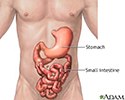Duodenal atresia
Duodenal atresia is a condition in which the first part of the small bowel (the duodenum ) has not developed properly. It is not open and cannot allow the passage of stomach contents.
Duodenum
The duodenum is the first part of the small intestine. It is located between the stomach and the middle part of the small intestine, or jejunum. Aft...

Causes
The cause of duodenal atresia is unknown. It is thought to result from problems during an embryo's development, in which the duodenum does not change from a solid to a tube-like structure, as it normally would.
Many infants with duodenal atresia also have Down syndrome. Duodenal atresia is often associated with other birth defects.
Symptoms
Symptoms of duodenal atresia include:
- Upper abdominal swelling (sometimes)
-
Early vomiting of large amounts, which may be greenish (containing
bile
)
Bile
Bile is a fluid that is made and released by the liver and stored in the gallbladder. Bile helps with digestion. It breaks down fats into fatty acid...
 ImageRead Article Now Book Mark Article
ImageRead Article Now Book Mark Article - Continued vomiting even when infant has not been fed for several hours
- No urination after first few voidings
- No bowel movements after first few meconium stools
Exams and Tests
A fetal ultrasound may show excessive amounts of amniotic fluid in the womb ( polyhydramnios ). It may also show swelling of the baby's stomach and part of the duodenum.
Amniotic fluid
Amniotic fluid is a clear, slightly yellowish liquid that surrounds the unborn baby (fetus) during pregnancy. It is contained in the amniotic sac....

Polyhydramnios
Polyhydramnios occurs when too much amniotic fluid builds up during pregnancy. It is also called amniotic fluid disorder, or hydramnios.

An abdominal x-ray may show air in the stomach and first part of duodenum, with no air beyond that. This is known as the double-bubble sign.
Abdominal x-ray
An abdominal x-ray is an imaging test to look at organs and structures in the abdomen. Organs include the spleen, stomach, and intestines. When the ...

Treatment
A tube is placed to decompress the stomach. Dehydration and electrolyte imbalances are corrected by providing fluids through an intravenous tube (IV, into a vein). Checking for other congenital anomalies should be done.
Surgery to correct the duodenal blockage is necessary, but not an emergency. The exact surgery will depend on the nature of the abnormality. Other problems (such as those related to Down syndrome) must be treated as appropriate.
Outlook (Prognosis)
Recovery from the duodenal atresia is expected after treatment. Untreated, the condition is deadly.
Possible Complications
These complications may occur:
- Other birth defects
-
Dehydration
Dehydration
Dehydration occurs when your body does not have as much water and fluids as it should. Dehydration can be mild, moderate, or severe, based on how muc...
 ImageRead Article Now Book Mark Article
ImageRead Article Now Book Mark Article
After surgery, there may be late complications such as:
- Swelling of the first part of the small bowel
- Problems with movement through the intestines
- Gastroesophageal reflux
When to Contact a Medical Professional
Call your health care provider if your newborn is:
- Feeding poorly or not at all
- Vomiting (not simply spitting up) or if the vomit is green
- Not urinating or having bowel movements
Prevention
There is no known prevention.
References
Applebaum H, Sydorak R. Duodenal atresia and stenosis-Annular pancreas. In: Coran, AG, Adzick NS, Krummel TM, et al. Pediatric Surgery . 7th ed. Philadelphia, PA: Elsevier Saunders; 2012:chap 81.
Bales C, Liacourus, CA. Duodenal obstruction. In: Kliegman, RM, Behrman RE, St. Geme III JW, Schor NF, Stanton BF, eds. Nelson Textbook of Pediatrics . 19th ed. Philadelphia, PA: Elsevier Saunders; 2011:chap 322.
National Organization for Rare Disorders. Duodenal atresia or stenosis. Available at: www.rarediseases.org/rare-diseases/duodenal-atresia-or-stenosis. Accessed July 23, 2015.
-
Stomach and small intestine - illustration
The stomach connects the esophagus to the small intestines and is where the majority of food digestion takes place.
Stomach and small intestine
illustration
Review Date: 4/21/2015
Reviewed By: Neil K. Kaneshiro, MD, MHA, Clinical Assistant Professor of Pediatrics, University of Washington School of Medicine, Seattle, WA. Also reviewed by David Zieve, MD, MHA, Isla Ogilvie, PhD, and the A.D.A.M. Editorial team.

